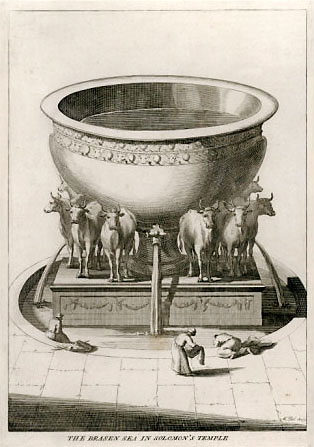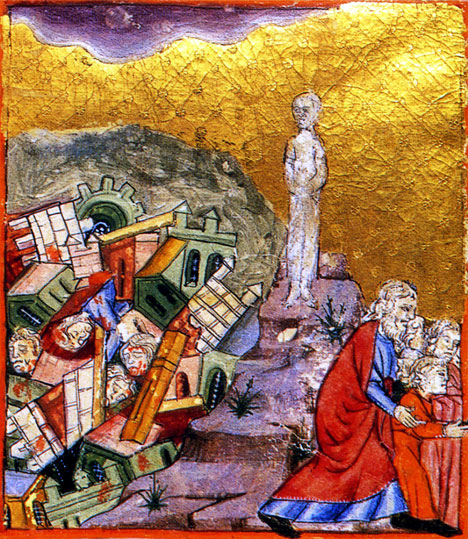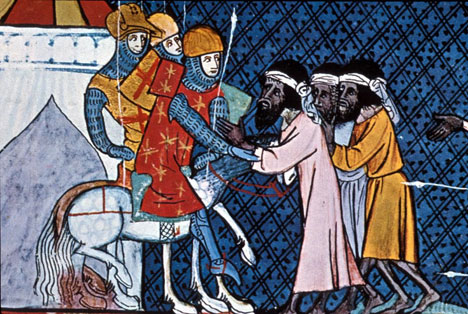Sociology and the New Covenant – 2
or Shekinah People
“The solution here is not, as Calvin believed, to dress the New Covenant’s ethical maturity in the puerile clothing of paedobaptism.”
In The Failure of the American Baptist Culture [PDF], James Jordan, Ray Sutton and others expose the rot at the heart of baptistic theology, which is inherently man-centred. The authors call us from a view of salvation in isolation to a wider vision of the meaning of baptism, which signifies the broader realities of the Covenant of Grace. I learned a great deal about history and Reformed theology, and thoroughly recommend it to you. In my view, however, they don’t go far enough. A call to understand the vital historical connection between circumcision and baptism certainly deals with the errors of the Anabaptists, but when rightly understood, the progressive nature of revelation also exposes the use of paedobaptism as a connection with the Old Covenant as entirely bogus.
The Beauty of Numbers – 7

Part 1 | Part 2 | Part 3 | Part 4 | Part 5 | Part 6
Sacred Geometry and Marked Men
Chapters 35-36 bring us to the end of this structural analysis of the book of Numbers. The position of this final cycle is in red.
Overview of Numbers
1 – Israel called and arranged as a New Creation
2 – Leadership disputes, failures and judgments
3 – Levitical offerings and “firstfruits” victories
4 – Israel fails the jealous inspection
5 – Israel’s national festal offerings
6 – Vengeance upon Midian, Dividing the Land
7 – Cities of Refuge; Marriage of Female Heirs
The Beauty of Numbers – 1
Bulls and Basins
“You are beautiful as Tirzah, my love, lovely as Jerusalem, awesome as an army with banners.” (Songs 6:4)
An online friend recently questioned the repetition found in Numbers 7. The offerings of each tribe are identical, yet each is listed in full. Surely, this was a waste of expensive parchment? Architecture is important to God, no less literary architecture, and it seems to me that the “fullness” of the Offertory in chapter 7 is the result—or the liturgical response, to the military “forming” of Israel in chapter 2.
Psalm 121 Halo
God Has You Covered
Parsing Psalms means consulting the Hebrew for the word order. This one was quite difficult, once again because English translations mess with things, and also because the Hebrew author likes to play with the matrix structures to make a point. I find I have to redo sections and keep shaking it up until it all falls into place. Is this sentence part of the previous stanza or the beginning of a new one? Or does this stanza have one line that gets expanded into its own pattern to make a point?
The good thing is that once it shakes out, there are some beautiful surprises. One of the gems in this Psalm is the sentence concerning the sun and the moon. In English it is simply two lines (a parallelism), but in Hebrew it is chiastic. Wonderful.
Continue reading
Angels in the Gate – Part 2
or The Liturgical Significance of Lot
 Part 1, The Architectural Significance of Lot’s Daughters, is here.
Part 1, The Architectural Significance of Lot’s Daughters, is here.
We’ve looked at the three-level Tabernacle structure in Genesis 19. That’s the rooms, and their doors, so what about the furniture?
The events follow the Bible Matrix, so an identification of how each step in the story fulfills the Creation Week might shed some light on the point of the details that the Spirit has included for us. And identifying how each step fulfills the Festal Calendar might also shed some light on the motivations of Lot and his daughters. The prefigurements of events nearly half a millennium in their future are breathtaking.
Angels in the Gate – Part 1
or The Architectural Significance of Lot’s Daughters
“His eyes [were] like a flame of fire …
[and] out of His mouth went a sharp two-edged sword”
(Revelation 1:14-16)
“I will set My face against you,
and you shall be defeated by your enemies.”
(Leviticus 26:17)
The Tabernacle layout to the Bible narratives is like the Globe Theatre to Shakespeare. [1] If we understand the correspondences we can get the “architectural” relationships worked out. The same blueprint appears again and again, and it explains the motivation of “righteous Lot” in the offering of his daughters to the men of Sodom. Continue reading
At The Hands of Infidels
or As Far as the East is from the West
“That very day Pilate and Herod became friends with each other, for previously they had been at enmity with each other.” (Luke 23:12)
“Secular humanism and Islam are merely the bipolar moods of Christless Christianity. They can be united only in suicide.”
Getting a grip on the Tabernacle layout helps us understand the architecture of Creation, the history of mankind and the structure of the entire Bible. After reading Mark Steyn on the Islamic/secular conflict in Europe, I was thinking that the same “Tabernacle” categories can be found in the world today. Whatever we do, however much we distort the truth, we are still bound by the walls and furnitures set up in Genesis 1. And, in my humble opinion, the light this sheds on the current conflict is not only revealing concerning its true nature, but it also helps us to predict its future.
The Weight of Literary Glory
“…and they saw the God of Israel. And there was under His feet as it were a paved work of sapphire stone, and it was like the very heavens in its clarity. But on the nobles of the children of Israel He did not lay His hand.” (Exodus 24:10-11)
Well, I’ve been blustering on about art and “intuition” in generalities for about a week now. Fluffy generalities are exactly the kind of thing that annoys me about many Biblical scholars, and I reckon it annoys God, too. They never seem to get down to specifics, and He is very specific. This shows in His architecture, and also in His literary architecture. So, here, in a section of Matthew 14, is a chance for me to get specific and show you what is possible with this “killer hermeneutic.” [1]
After a brief look at the structure of this passage the other day, I thought I’d spend some more time on it. A closer analysis has revealed an even greater beauty than I expected. (I have briefly referenced the order of words in the Greek to avoid any great missteps, so it may not be perfect, but it’s close.) Much learning hath indeed made me mad but I hope you’ll take a few minutes to see this passage through my eyes.
































